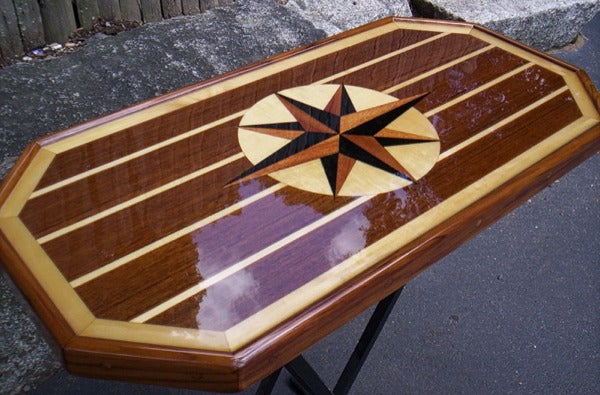The epoxy process is divided into several major steps; there's mixing—when you measure your batches—seal-coating, more mixing, pouring—often followed by air bubble removal, then finally curing.
Pouring epoxy may seem like the easiest part of the entire process, but there are still a few things that can go wrong, resulting in irreversible imperfections. Thankfully, these issues are easy to prevent.
In this article of our Primaloc Basics series, we'll be explaining how to avoid four of the most common mistakes newcomers make when pouring their epoxy batches.
We'll be assuming you're using a high-quality resin such as our Primaloc Bar & Table Top Epoxy, because with lower-grade resins, other issues may present themselves due to the substandard quality of the product itself, rather than through user error.
Primaloc Basics: Four Common Mistakes to Avoid When Pouring Epoxy
To achieve the beautiful, glasslike finish that clear resin is known for, follow these pouring guidelines:
- Always prepare your substrate surface prior to pouring.
- Make sure your epoxy is in the right temperature range.
- Mix your epoxy carefully, according to the included instructions.
- Be careful not to pour a layer that's too thick.
Guideline #1: Always Prepare Your Substrate Surface Prior to Pouring
Before you pour a flood coat of epoxy onto a substrate, there are a few things you should do to prepare it.
To start, make sure the surface is clean, free of dust and other sediment. Once you've done that, you'll most likely want to apply a seal coat. This will remove any air from the pores in your substrate, making the flood coat easier to manage later.
It's also a good idea to place all the supplies you'll be using in a convenient location that's easy to reach but not in your way. It's not unheard of for someone to knock over their own supplies, causing a mess or worse.
Guideline #2: Make Sure Your Epoxy Is in the Right Temperature Range
Good epoxy resin cures best at a certain range, typically ideal at 75°F, though with our Primaloc epoxy, this can safely go as high as 100°F and still cure properly.
Using your epoxy resin outside of this range can make it more difficult to mix and induce "clouding" when pouring, resulting a muddy finish rather than the pristine transparent result you'd expect.
Our Primaloc Bar & Table Top Epoxy cures best at: 75°F to 100°F, so stay in that range if you've chosen Primaloc.
It's also a good idea to maintain a relative humidity of 60% or below in your environment. Excessive moisture in the air can stunt the epoxy curing speed, causing it to take much longer. If you have no choice, be sure to give it plenty of extra time, as a precaution.
Guideline #3: Mix the Epoxy Carefully, According to Your Brand's Instructions
Most clear resins are two-part epoxies. This means you must mix two separate components together to start the curing process. However, once the epoxy is mixed together, you have a limited time to apply it to your substrate, whether you're doing a seal coat or a flood coat.
Typically this amount of time is about 5 to 10 minutes, depending on how smoothly the mixing went. To avoid issues, always make sure you mix up a batch only when you're ready to brush/pour on the epoxy.
Every epoxy resin also has a mixing ratio that you must adhere to for it to properly cure. For Primaloc Bar & Table Top Epoxy, it's a convenient 1:1 ratio, meaning both components should be mixed together in equal proportions.
When measuring, do so by volume, not weight. Epoxy components have different levels of density, resulting in slightly different weights for the same amount.
When mixing, use suitable stir sticks for batches of less than a gallon. Manual mixing should last about 3 to 4 minutes. Just stir thoroughly, scraping the sides and bottom occasionally to prevent any resin from clinging.
If you're mixing up an entire gallon, you can use an electric drill set to medium speed with a mixing drill bit to make the process considerably less strenuous. Just be sure to scrape the sides and bottom with a stir stick every half minute or so to ensure that the components get blended properly, and keep the drill bit low in the container to avoid pulling in air while it's rotating.
If you'll be using pigments or dyes, add those about halfway into the mixing process. Start with a small amount and add more until you achieve the desired depth of color.
Guideline #4: Be Careful Not to Pour a Layer That's Too Thick
Most epoxies are self-leveling, meaning that they naturally spread out to a particular thickness. Unless they're specifically low-viscosity, they should only be poured in layers that are at their natural thickness level. Pouring thicker layers for an epoxy not suited for it can induce air bubbles and other issues.
Instead, when a thicker depth is needed for your finish, you can pour a single layer, then wait for 4 hours before pouring another. This process can be repeated until you reach the necessary depth.
Primaloc Epoxy: Premium Epoxy for Premium Results
When it comes to epoxy resin, Primaloc Epoxy gets the job done. Our epoxy resin is premium-grade, with high performance in every category, and knowing how to pour epoxy resin will allow you to take full advantage of each feature.
Epoxy resin can be beautiful, strong, and long-lasting—which is why you shouldn't compromise on quality. With Primaloc Epoxy Resin, you get the ultimate finish in durability and visual appeal.
Protect your surfaces by giving them a rock-solid epoxy finish. Choose strong. Choose reliable. Choose Primaloc.



